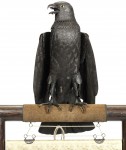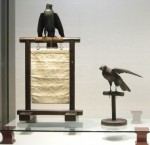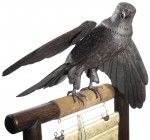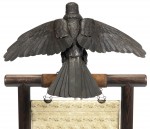 Forget the Maltese Falcon, it’s this Japanese hawk that’s the stuff that dreams are made of. It’s coming up for auction at Bonham’s on May 16th and it could be yours for an estimated £120,000 ($185,628). This masterpiece of wrought iron craftsmanship made in the late 19th century probably by artist and metalworker Itao Shinjiro, is fully articulated. Its limbs and claws move; the head turns 180 degrees; the beak opens and closes; the neck, tail and wing feathers can be stretched out or shortened to mimic the animal at rest or in flight.
Forget the Maltese Falcon, it’s this Japanese hawk that’s the stuff that dreams are made of. It’s coming up for auction at Bonham’s on May 16th and it could be yours for an estimated £120,000 ($185,628). This masterpiece of wrought iron craftsmanship made in the late 19th century probably by artist and metalworker Itao Shinjiro, is fully articulated. Its limbs and claws move; the head turns 180 degrees; the beak opens and closes; the neck, tail and wing feathers can be stretched out or shortened to mimic the animal at rest or in flight.
 There are only two other comparable hawks known to exist, one in the Tokyo National Museum and the other in a French private collection. This one is larger and more elaborate than the one in Tokyo. It’s being sold by the Kiyomizu Sannenzaka Museum in Kyoto, a small private museum with an exceptional collection of high quality pieces of lacquerware, cloisonné and metal work from the late Edo and Meiji periods. The Kyoto museum loaned their gorgeous hawk to the Tokyo National Museum for a 2008 exhibition on jizai okimono (jizai = articulated, okimono = ornamental figures), realistic, articulated animal figures made of various metals.
There are only two other comparable hawks known to exist, one in the Tokyo National Museum and the other in a French private collection. This one is larger and more elaborate than the one in Tokyo. It’s being sold by the Kiyomizu Sannenzaka Museum in Kyoto, a small private museum with an exceptional collection of high quality pieces of lacquerware, cloisonné and metal work from the late Edo and Meiji periods. The Kyoto museum loaned their gorgeous hawk to the Tokyo National Museum for a 2008 exhibition on jizai okimono (jizai = articulated, okimono = ornamental figures), realistic, articulated animal figures made of various metals.
 It’s an art form that’s as mysterious as it is beautiful. There is little evidence in the historical record regarding their origins and development. Although they began to be made in the Edo period, we only know this from the dating of extant pieces. There are no documents or contemporary sources describing the early days of the art. The earliest pieces date to the first quarter of the 18th century and were made by the Myochin family, illustrious metalworkers who started out as armorers to the samurai during the civil wars of the 16th century.
It’s an art form that’s as mysterious as it is beautiful. There is little evidence in the historical record regarding their origins and development. Although they began to be made in the Edo period, we only know this from the dating of extant pieces. There are no documents or contemporary sources describing the early days of the art. The earliest pieces date to the first quarter of the 18th century and were made by the Myochin family, illustrious metalworkers who started out as armorers to the samurai during the civil wars of the 16th century.
After Tokugawa Ieyasu won the Battle of Sekigahara in 1600 and consolidated his power as de facto ruler of Japan under the Tokugawa Shogunate, a long period of peace followed. Later known as the Edo period, it lasted 250 years. For the first century of peace business proceeded apace. Nobody knew how long the peace would last so warriors still commissioned plenty of armor even if it was only used for ceremonial purposes. Eventually, though, without constant war-making the market for armorers’ wares dried up and competition for the business that remained was fierce.
 Compelled to look for new revenue streams, the Myochin studio and others turned to art. Decorative metal work was a natural evolution for experts with their very specific set of skills. Craftsmen adept at the forging and hammering of metal began making everyday consumer goods like tea kettles and boxes.
Compelled to look for new revenue streams, the Myochin studio and others turned to art. Decorative metal work was a natural evolution for experts with their very specific set of skills. Craftsmen adept at the forging and hammering of metal began making everyday consumer goods like tea kettles and boxes.
This kind of work was pedestrian, however, and not a proper showcase for their skills. Probably inspired by Chinese pieces, the armorers moved from quotidian items to the creation of complex, elaborate jizai okimono. It makes sense. A larger piece composed of a myriad small scales that can move in a naturalistic fashion could describe armor just as much as it describes this hawk or the amazing articulated dragon in the collection of the Art Institute of Chicago.
 According to a description of the hawk in an 1894 issue of The Magazine of Japanese Art published after the piece took second place at the 1894 Spring Exhibition of the Japan Art Association, the concept of articulated metal animals originated in China, but it was Japanese craftsmanship that caught the imagination of the West at the end of the 19th century when the opening of Japanese markets (by force, of course) made Orientalism a major trend.
According to a description of the hawk in an 1894 issue of The Magazine of Japanese Art published after the piece took second place at the 1894 Spring Exhibition of the Japan Art Association, the concept of articulated metal animals originated in China, but it was Japanese craftsmanship that caught the imagination of the West at the end of the 19th century when the opening of Japanese markets (by force, of course) made Orientalism a major trend.
“We have certainly succeeded in making a nobler and more practical use of it than the Chinese ever seem to have thought of. Mr. Itawo [sic], our artist, is … a metalworker of no common ability, having a particular aptitude for the kind above mentioned in wrought or hammered iron … The beautiful execution and tone of color given to the material, alone, not to say anything about the ingenious arrangement, would entitle it to be classed among works of high art….
Their rise of popularity in the West was in step with the decline of interest in the Japanese market. The unique beauty of the jizai okimono was underappreciated in the wider population until a metalwork exhibition at the Tokyo National Museum in October of 1983 brought them back into the limelight. Now they are highly sought after pieces, with the work of Itao Shinjiro being particularly prized because very few of his figures have survived.